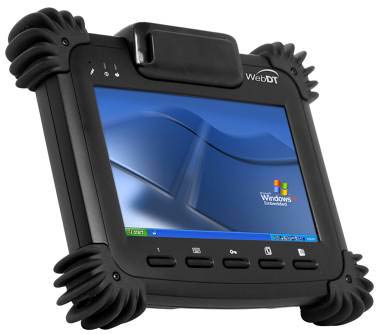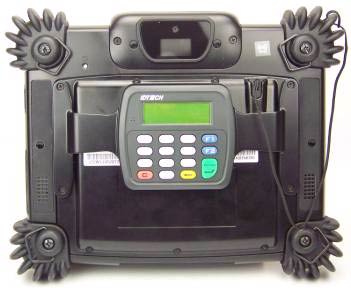|
DT Research WebDT 372
Compact, rugged tablet offers secure payment transactions anywhere, even has a PIN pad option
(by Conrad H. Blickenstorfer)
The WebDT 372, introduced in January of 2011 by DT Research, is the company's most modern tablet to date, packing a lot of technology into a handy tablet with a wide-format display. The WebDT 372 is also remarkable in that it is the first mobile tablet offering a fully integrated encrypted PIN pad option for secure payment transactions.

When you look at the specs of the WebDT 372, you essentially see a very compact industrial market netbook without a keyboard. The device has the 7-inch display with the 1024 x 600 pixel resolution seen in tens of millions of second gen commercial netbooks, but there's an outdoor-viewable option, and the device uses resistive touch instead of the projected-capacitive touch popularized by the iPhone and iPad (that's because capacitive cannot handle gloves, and gloves are often a fact of life on the job). Under the hood of the WebDT 390 sits an Intel Atom chip, but it's the the Atom Z530 favored for embedded and industrial applications. And, of course, the WebDT is entirely more rugged than any commercial tablet.
Measuring 9.3 x 7.4 x 1.6 inches and weighing about two and a half pounds, the WebDT is considerably smaller and much lighter than full-size vertical market tablets. However, like many larger industrial tablets, the WebDT 372 can be equipped with a variety of data capture options. Depending on your needs, the device may include a 1D/2D omnidirectional Intermec imager, a RFID reader, a Smart Card reader, and also a 3-megapixel autofocus camera. On the wireless communications side, the WebDT 372 is technologically state-of-the-art as well: a Gobi 2000 card that allows using virtually any network out there is available (and includes GPS for positioning and navigation as well).
What truly sets the WebDT 372 apart, though, is the ability to configure it with a fully integrated encrypted PIN pad and magnetic stripe reader for secure payment transactions where customers never lose sight of their card

With this latest WebDT model, DT Research offers a lightweight, ruggedized tablet computer suitable for a large variety of sales floor, warehouse and field service applications, enabling service staff to provide a fast and secure experience for more personalized customer interactions. It's more rugged netbook than rugged iPad, and those who've come to expect the effortless operation of a capacitive touch screen may balk at having to use a stylus with Microsoft Windows, but for now that combination still remains the supported standard in numerous IT operations worldwide.
How do the tablets in DT Research's current tablet lineup differ? They mostly use the same (up-to-date) electronics, but the older 312 and 362 use 4:3 aspect ratio 10.4-inch XGA (1024 x 768) and 8.4-inch SVGA (800 x 600) displays whereas the new 372 uses a 7-inch and the 390 a 8.9-inch SWVGA (1024 x 600) display. All offer good protection via large rubber bumpers, but only the 372 and 390, which are the latest additions to the line, offer IP54 sealing, RFID and Gobi WWAN. The 312 and 362, however, are a bit lighter and thinner (around two pounds and less than an inch thick) than the 372 (2.5 pounds and 1.25 inches thick) and 390 (2.5 pounds and 1.25 inches thick).
DT Research, Inc., with headquarters in San Jose, California, develops and manufactures information appliances including tablet devices and digital signage solutions for vertical markets. For years, DT Research was clearly ahead of the times with its "web appliance" tablets, but ever since the introduction of the Apple iPad, tablets are hot and products like the DT Research WebDT tablets are getting increased attention. As of early 2011, the market opportunity, in essence, is providing tablet functionality in an enclosure far more rugged than the iPad, and DT Research has been in just that market for years.
|












